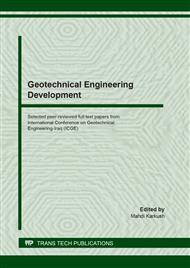p.302
p.311
p.319
p.328
p.334
p.341
p.349
p.358
p.367
Numerical Analysis of One-Dimensional Consolidation in Fine-Grained Soils
Abstract:
The purpose of this study is to discuss which constitutive law can describes at best the observed behavior of Silt and Gravelly Clay on the basis of experimental and analytical results. To find numerical solution for saturated soils in oedometer test Plaxis 2D the finite element software was used. In order to obtain the compressibility, excess pore pressure and degree of consolidation curves; two constitutive laws were used in this work: the Soft Soil Model ‘SSM’ and the Modified Cam Clay Model ‘MCC’. Predicted results were found in good agreement with measurements obtained from experimental test and analytical solutions. The Soft Soil is in good agreement with experimental results in the compressibility curve; however the Modified Cam Clay Model is the most appropriate if compared with the analytical solution.
Info:
Periodical:
Pages:
334-340
Citation:
Online since:
August 2020
Authors:
Keywords:
Price:
Сopyright:
© 2020 Trans Tech Publications Ltd. All Rights Reserved
Share:
Citation:


